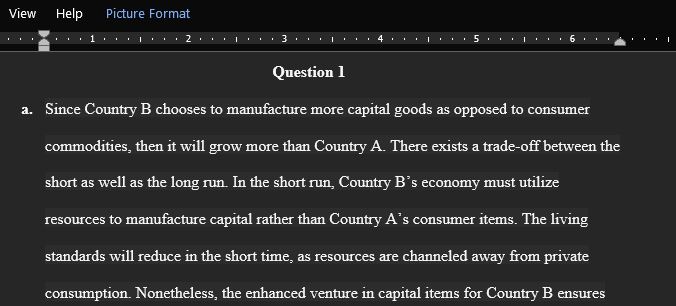Assume countries A and B have identical factors of production
1. (a) Assume countries A and B have identical factors of production (and therefore share the same production-possibility curve), but differ only in that country A has a strong preference for consumer goods over capital goods while country B places a heavy emphasis on capital goods. Looking out 15 years later, how would their PP curves now differ and why?
(b) Define “opportunity cost” and provide one specific example.
(c) Identify two different variables that may be responsible for a shift to the left in the demand for desktop computers; and two that may be responsible for a shift to the left in the supply of desktop computers.
(d) Name two products you regard as inferior goods.
2. For each of the following situations, draw a separate properly labeled supply and/or demand curve relating to 4K HDTVs, indicating the primary implications of the development described. In your own words, briefly describe how the supply and/or demand curves are affected. Indicate the implications for the equilibrium price and quantity relating to 4K HDTVs.
(a) Published research on 4K HDTVs reveals that their higher resolution screens provide less strain on viewers’ eyes compared with regular TVs.
(b) A news report indicates that a COVID outbreak has forced the shutdown of the world’s leading 4K HDTV manufacturing plant.
(c) Representatives of a highly respected hi-tech firm announce the development of a new technology that will enable 4K HDTVs to be produced at considerably lower cost per unit.
(d) The price of 4K HDTVs falls by an average $150 per unit.
(e) The union representing HDTV plant workers negotiates improved health insurance benefits.
3. (a) Calculate the price elasticity of demand (showing your calculations) if the price of a given smartphone is reduced from $939 to $869, causing the quantity demanded per month to rise from 109 units to 132 units. Is this elastic or inelastic demand?
(b) Identify three different products whose demand is likely to be quite inelastic, explaining in each case the characteristic that likely makes its demand inelastic.
4. What is an excise tax? What determines the sharing of the burden of that tax between producers and consumers? Use a diagram to illustrate your response.
5. “Profit” is viewed differently by an accountant and an economist. Explain. What is the difference in their responses when each declares that “Total revenue minus total cost equals zero.” Explain.
Answer preview for Assume countries A and B have identical factors of production
Access the full answer containing 1119 words by clicking the below purchase button.

